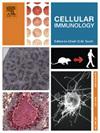Curcumin mitigates systemic lupus erythematosus by suppressing double-negative T cells through cell apoptosis
IF 2.9
4区 医学
Q2 CELL BIOLOGY
引用次数: 0
Abstract
Objective
Curcumin extracted from the rhizome of Curcuma longa has anti-inflammatory, antioxidant and antitumour properties. In previous studies, curcumin has been reported to have therapeutic effects on systemic lupus erythematosus (SLE), in which the upregulation of double-negative T (DNT) cells was detected. Therefore, the purpose of this study is to explore the role of curcumin in the remission of SLE by regulating DNT cell homeostasis.
Methods
Two established murine models of lupus, MRL/lpr mice and R848-induced mice, were administered with 50 mg/kg curcumin to evaluate its therapeutic effects. Flow cytometry was used to detect the proportions of DNT cells, Treg cells and Th cells in mouse tissues. H&E staining and immunofluorescence were used to assess inflammatory cell infiltration and immune complex deposition in the kidney. Enzyme-linked immunosorbent assay (ELISA) and real-time quantitative PCR (RT-qPCR) were used to detect the expression of inflammatory factors. RNA sequencing was used to identify differentially expressed genes and explore regulatory mechanisms, and western blot was used to detect protein expression.
Results
Our results suggest that the accumulation of DNT cells is closely associated with lupus pathogenesis and development in both mouse models, whereas curcumin treatment can improve lupus serological and immunological profiles, and regulate T-cell homeostasis, especially DNT cells. Further studies demonstrated that curcumin promoted DNT cell apoptosis to eventually decrease the accumulation of DNT cells.
Conclusion
Curcumin can improve lupus serological and immunological profiles as well as renal pathology by suppressing DNT cells, and may be a potential candidate for the treatment of SLE.
姜黄素通过细胞凋亡抑制双阴性T细胞减轻系统性红斑狼疮
目的从姜黄根茎中提取姜黄素具有抗炎、抗氧化和抗肿瘤的作用。在以往的研究中,姜黄素被报道对系统性红斑狼疮(SLE)有治疗作用,其中检测到双阴性T (DNT)细胞的上调。因此,本研究的目的是探讨姜黄素通过调节DNT细胞稳态在SLE缓解中的作用。方法建立狼疮模型,MRL/lpr小鼠和r848诱导小鼠分别给予50 mg/kg姜黄素,观察其治疗狼疮的效果。采用流式细胞术检测小鼠组织中DNT细胞、Treg细胞和Th细胞的比例。采用H&;E染色和免疫荧光法评估肾脏炎症细胞浸润和免疫复合物沉积。采用酶联免疫吸附试验(ELISA)和实时定量PCR (RT-qPCR)检测炎症因子的表达。采用RNA测序技术鉴定差异表达基因并探索调控机制,采用western blot技术检测蛋白表达。结果在两种小鼠模型中,DNT细胞的积累与狼疮的发病和发展密切相关,而姜黄素治疗可以改善狼疮的血清学和免疫学特征,调节t细胞稳态,尤其是DNT细胞。进一步研究表明,姜黄素促进DNT细胞凋亡,最终减少DNT细胞的积累。结论姜黄素可通过抑制DNT细胞改善狼疮血清学、免疫学及肾脏病理,可能是治疗狼疮的潜在候选药物。
本文章由计算机程序翻译,如有差异,请以英文原文为准。
求助全文
约1分钟内获得全文
求助全文
来源期刊

Cellular immunology
生物-免疫学
CiteScore
8.20
自引率
2.30%
发文量
102
审稿时长
30 days
期刊介绍:
Cellular Immunology publishes original investigations concerned with the immunological activities of cells in experimental or clinical situations. The scope of the journal encompasses the broad area of in vitro and in vivo studies of cellular immune responses. Purely clinical descriptive studies are not considered.
Research Areas include:
• Antigen receptor sites
• Autoimmunity
• Delayed-type hypersensitivity or cellular immunity
• Immunologic deficiency states and their reconstitution
• Immunologic surveillance and tumor immunity
• Immunomodulation
• Immunotherapy
• Lymphokines and cytokines
• Nonantibody immunity
• Parasite immunology
• Resistance to intracellular microbial and viral infection
• Thymus and lymphocyte immunobiology
• Transplantation immunology
• Tumor immunity.
 求助内容:
求助内容: 应助结果提醒方式:
应助结果提醒方式:


